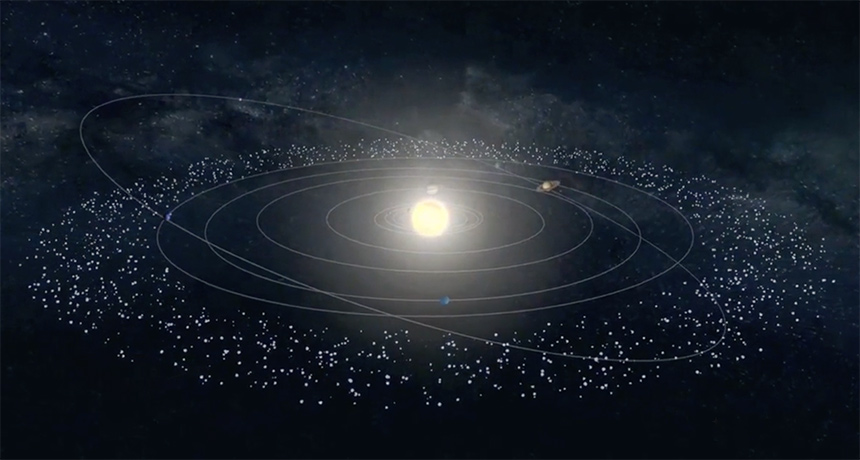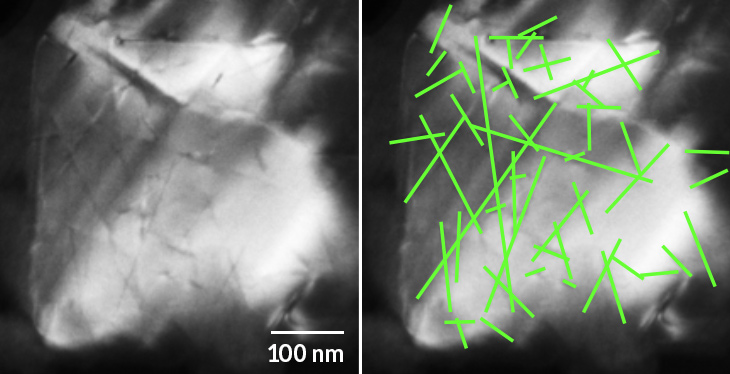Kuiper Belt dust may be in our atmosphere (and NASA labs) right now
Astronomers may not have far to go to study a piece of the distant, icy region

COME FROM AWAY Some interplanetary dust particles that end up in Earth’s atmosphere may have started life in the faraway Kuiper Belt (illustrated), a region of icy objects farther from the sun than Neptune.
ESA
- More than 2 years ago
THE WOODLANDS, Texas — Grains of dust from the edge of the solar system could be finding their way to Earth. And NASA may already have a handful of the debris, researchers report.
With an estimated 40,000 tons of space dust settling in Earth’s stratosphere every year, the U.S. space agency has been flying balloon and aircraft missions since the 1970s to collect samples. The particles, which can be just a few tens of micrometers wide, have long been thought to come mostly from comets and asteroids closer to the sun than Jupiter (SN Online: 3/19/19).
But it turns out that some of the particles may have come from the Kuiper Belt, a distant region of icy objects orbiting beyond Neptune, NASA planetary scientist Lindsay Keller said March 21 at the Lunar and Planetary Science Conference. Studying those particles could reveal what distant, mysterious objects in the Kuiper Belt are made of, and perhaps how they formed (SN Online: 3/18/19).
“We’re not going to get a mission out to a Kuiper Belt object to actually collect [dust] samples anytime soon,” Keller said. “But we have samples of these things in the stratospheric dust collections here at NASA.”
One way to find a dust grain’s home is to probe the particle for microscopic tracks where heavy charged particles from solar flares punched through. The more tracks a grain has, the longer it has wandered in space — and the more likely it originated far from Earth, says Keller, who works at the Johnson Space Center in Houston.
But to determine precisely how long a dust grain has spent traveling space, Keller first needed to know how many tracks a grain typically picks up per year. Measuring that rate required a sample with a known age and known track density — criteria met only by moon rocks brought back on the Apollo missions. But the last track-rate estimate was done in 1975 and with less precise instruments than are available today.

So Keller and planetary scientist George Flynn of SUNY Plattsburgh reexamined that same Apollo rock with a modern electron microscope. They found that the rate at which rocks pick up flare tracks was about 20 times lower than the previous study estimated.
That means it takes longer for dust flakes to pick up tracks than astronomers assumed. When Keller and Flynn counted the number of tracks in 14 atmospheric dust grains, the pair found that some of the particles must have spent millions of years out in space — far too long to have come just from between Mars and Jupiter.
Grains specifically from the Kuiper Belt would have wandered 10 million years to reach Earth’s stratosphere, the researchers calculated. That’s “pretty solid evidence that we’re collecting Kuiper Belt dust right here,” Keller says.
Four of the particles contained minerals that had to have formed through interactions with liquid water. That’s surprising; the Kuiper Belt is thought to be too cold for water to be liquid.
“Many of these particles, if they in fact are from the Kuiper Belt, tell you that some of the minerals in Kuiper Belt objects formed in the presence of liquid water,” Keller says. The water probably came from collisions between Kuiper Belt objects that produced enough heat to melt ice, he says.
“I think it’s incredible if Lindsay Keller has shown that he has pieces of Kuiper Belt dust in his lab,” says planetary scientist Carey Lisse of the Johns Hopkins University Applied Physics Laboratory in Laurel, Md. But more work needs to be done to confirm that the dust really came from the Kuiper Belt, he says, and wasn’t just sitting on an asteroid for millions of years. “Lindsay needs to get a lot more samples,” Lisse says. “But I do think he’s on to something.”
Lisse works on NASA’s New Horizons mission, which found plenty of dust in the outer solar system and measured its abundance near Pluto when the spacecraft flew past the dwarf planet in 2015. Based on those results, he finds it unsurprising that some of that dust has made it to Earth. But it is “really cool,” he says. “We can actually try to figure out what the Kuiper Belt is made of.”
Editor’s note: This story was updated April 8, 2019, to correct that the newly calculated flare track rate was about 20 times lower than the rate calculated in 1975, not two orders of a magnitude lower.







